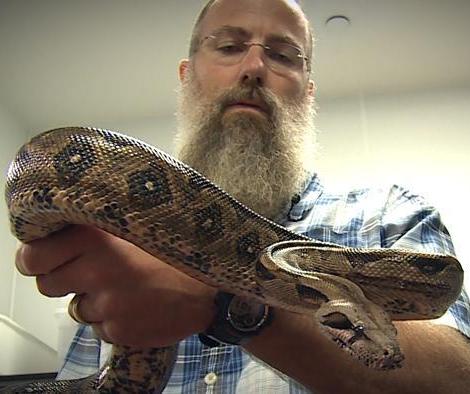Boas Constrict Prey’s Blood Flow, Not Air Flow
CARLISLE, Pa., July 23 (UPI) — Predators have a variety of methods for killing their dinner. Some paralyze their prey, others mortally wound their victims. Some use poison, some use teamwork.
Until now, most biologists and amateur wildlife fans assumed the boa constrictor suffocated its quarry.
But new research, published in the August issue of The Journal of Experimental Biology, proves that assumption false. The squeeze-happy snake cuts off its victim’s blood flow, not air supply.
We now know this because researchers in Pennsylvania did a unique set of experiments, measuring oxygen levels and pressure in the blood of rats both before and after being killed by boas.
The evidence showed that victims squeezed by boas, massive nonvenomous snakesnative to Central and South America, quickly lost their ability to pump blood.
“The heart literally doesn’t have enough strength to push against the pressure,” study author Scott Boback, an ecologist at Dickinson College in Carlisle, Pennsylvania, told National Geographic.
One of the clues that suffocation wasn’t the snake’s main tool of execution was that death comes so quickly for a boa’s victims. Suffocation usually takes a while, but as researchers found out, boas killed their prey within seconds.
Real-time blood pressure and circulation data confirmed this reality.
“I remember being in the room, and the students were looking at the data in disbelief that it happened that fast,” Boback said in a press release. “We could see the arterial pressure go down, the venous pressure go up, and we could see this right when the snake was doing it [squeezing].”
Of course, air flow restriction is a certain byproduct of the snake’s crushing squeeze.
“If the snake is wrapping around the chest, it could also be limiting breathing, too,”Boback told BBC. “But an absence of blood flow will cause death more rapidly than suffocation.”
Boback and his colleagues say the research offers insight into the evolution of serpent hunting skills. Early snakes likely didn’t possess the ability to shut off blood flow, and thus had to aim for only small victims. The acquisition of the skill likely allowed some snakes to grow larger as they were emboldened to take down larger and larger prey.
Like Us on Facebook for more stories from GephardtDaily.com






